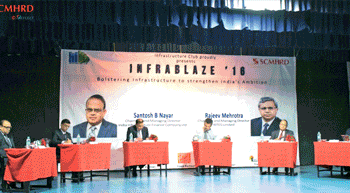Infrablaze 2016, a flagship event of the Symbiosis Centre for Management and Human Resource Development (SCMHRD), witnessed an audience made up of students and equally enthusiastic academicians.
The audience at InfraBlaze 2016 was waiting to hear the expert opinions of Santosh Nayar, CMD, IIFCL, and Rajeev Mehrotra, CMD of RITES Ltd, on the state of infrastructure development in India.
Nayar started with saying that it would take 100 years for the government to spend `1 trillion on India´s infrastructure sector.
Raising his concern over lack of skilled manpower in the infrastructure sector, Nayar said that the word ´need´ has been replaced by ´compulsion´ as far as infrastructure is concerned in India. This is mainly because, if India´s GDP has to grow at 8 per cent, the economy requires foreign direct investment, increase in manufacturing activity, etc. And this can happen only when we have a solid infrastructure backup. Nayar lauded the efforts of the government. He said, ´Despite many impediments, all efforts have been made by the government to give world-class infrastructure to its citizens.´
Focused approach
In his presentation to the students, he spoke about the need for a focused approach towards the infrastructure sector, as the country is still far behind other nations. According to him, without infrastructure, our exports will be expensive, a negative factor for India as the country will become less competitive.
Nayar made a few suggestions, substantiated with facts. So far, the infrastructure sector has been backed by commercial banks. However, unless banks lend for at least a 30-year period, the financial model will not work out for the infrastructure sector.
Through his presentation, Nayar made students aware about how banks in India are under pressure, due to their lending Rs.12 lakh crore in the last 70 years to the infrastructure sector. Now, lenders are caught in a big dilemma due to sanctity of contracts. He also mentioned about the need for Basel III compliance for the infrastructure sector, and its implications for the future. According to him, the Kelkar Committee´s suggestions can be effective only with legislative backing, and there is a need to create financial institutions beyond commercial banks.
Meanwhile, Nayar backed the concept of municipal bonds in India. ´If a country like Malaysia can have a world-recognised bond market, then why not India?´ he asked. He added that for successful implementation of municipal bonds, the government needs to financially strengthen urban local bodies.
Nayar also raised a valid point on the use of pension funds for the infrastructure sector. In his address, he mentioned about how countries other than India are utilising pension funds. Unfortunately for India, the utilisation of pension funds can happen only in´AA´ rated instruments. However, the fact is, no infrastructure project can get´AA´ ratings.
While concluding his presentation, Nayar felt the need to have a specialised institution which will monitor and undertake due diligence for the infrastructure sector. He said, ´We are working with the government to create an organisation, which will offer a guarantee for infrastructure projects in India.´
The next speaker was Rajeev Mehrotra, CMD of RITES Ltd. While sharing his 32 years of experience in the field of energy, risk management, finance, etc., with the students, he lauded the efforts of SCMHRD, which was creating specialists for the infrastructure sector – a desperate need for this industry.
He asked the students to take risks, extend and test their capabilities, and follow the ethical path throughout their corporate career. ´Hard work has no substitute,´ he said. One should stick to one´s values, and follow one´s conscience when making a decision. Mehrotra expressed these sentiments to the students, using examples from his personal life.
He also emphasised that an eagerness to learn, doing most challenging tasks and growing beyond one´s comfort zone are important ingredients in one´s professional development. Mehrotra also appealed to the youngsters to understand and fulfill their responsibility towards society and the nation.
´Until now, as a matter of fact, we all have done a job on a´need-to´ basis, but now, the infrastructure industry requires skilled project managers,´ he said.
The infrastructure sector has taken the advantage of the earlier reforms in terms of credit, legislation and relaxation from the Inspector Raj. However, the entire infrastructure of India has not been able to evolve as compared to other reforms. In terms of challenges, Mehrotra explained that key infra projects like railways, highways, ports, airports and telecom, among others, all have similar kind of challenges. However, the solutions may not be the same for all these sectors.
Mehrotra had a few words of wisdom for the students. He said that the right attitude, and effective interpersonal skills, are the major areas that decide the corporate trajectory of an individual.
At the end, a panel discussion touched upon various dimensions of the infrastructure sector. Speakers shared their experience in their respective domains and gave insights on:
- Global experience in infrastructure financing;
- Evolution of PPP models in India;
- New mechanism to attract funds for the infrastructure sector;
- Development of infrastructure and starting manufacturing hubs in India;
- Nuclear energy and the sharing of resources between states;
- Scope of geothermal energy and the concept of energy mix.
About InfraBlaze
InfraBlaze is an initiative by SCMHRD, India´s first business school-led infrastructure summit. It aims to bring together policymakers, business and thought leaders, government decision makers and academicians under a single roof to analyse the hurdles facing Indian infrastructure, identify the gaps in policies and share implementable solutions to fast track projects in order to give infrastructure the place it deserves in the economy, and put the nation on the growth trajectory.



Leave a Reply
You must be logged in to post a comment.